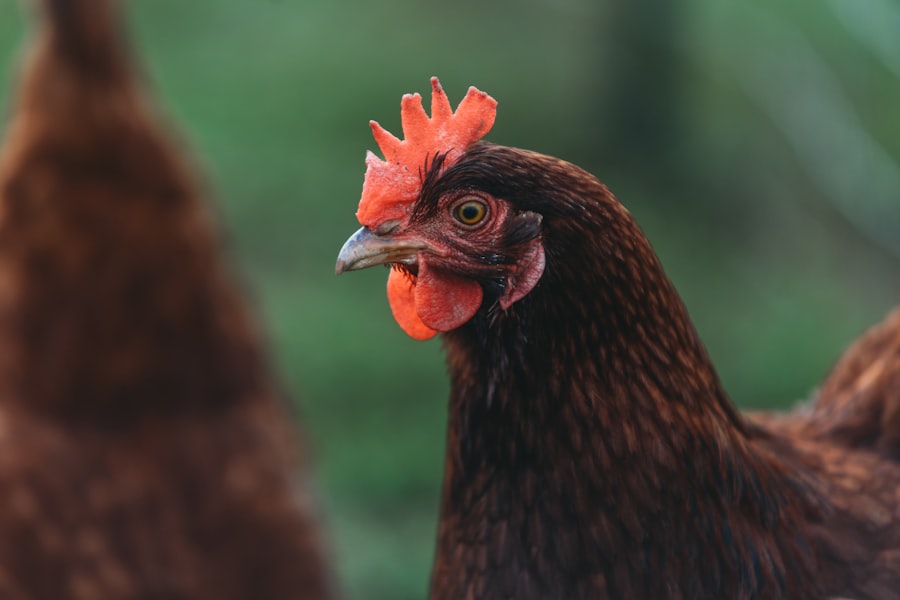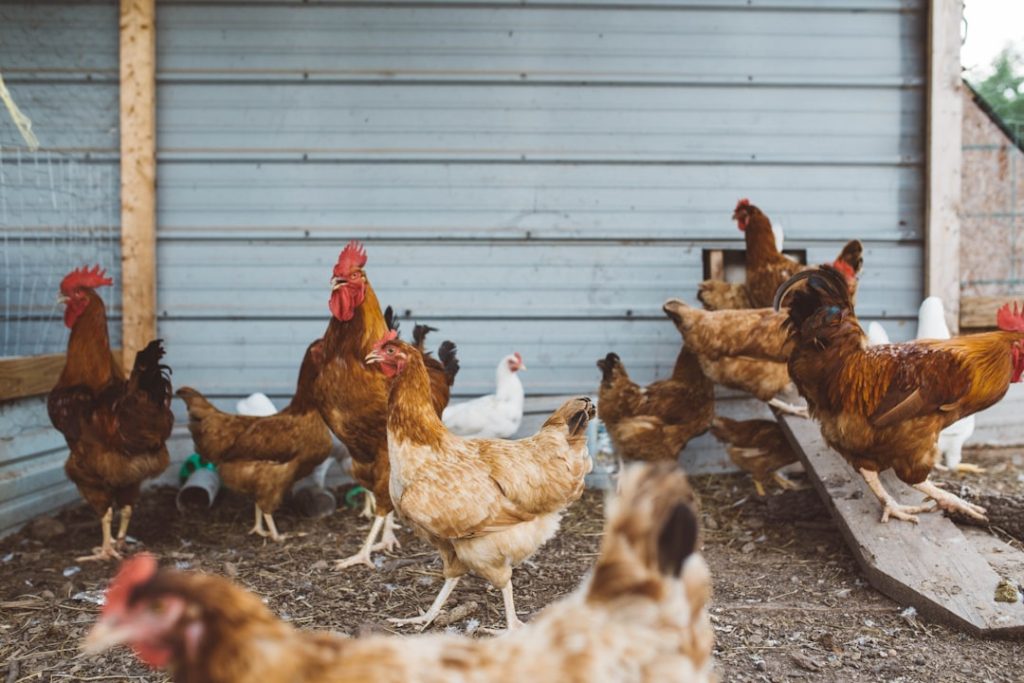When selecting meat chicken breeds for breeding, it’s essential to consider various factors to ensure success. Popular meat chicken breeds include Cornish Cross, Red Ranger, and Freedom Ranger. Cornish Cross is known for rapid growth and high meat yield, making it ideal for commercial production.
Red Ranger grows more slowly and is well-suited for free-range and pasture-based systems. Freedom Ranger is a hybrid breed combining traits from both Cornish Cross and Red Ranger, offering versatility for small-scale producers. Important considerations when choosing breeds include growth rate, meat yield, feed efficiency, disease resistance, and overall hardiness.
Some breeds may be more susceptible to certain health issues or require specific management practices. Thorough research is crucial before making a decision. The optimal breed for a breeding operation depends on specific goals, resources, and production systems.
Evaluating the characteristics and requirements of different meat chicken breeds allows for an informed decision that supports a successful breeding program. This careful selection process is vital for both commercial and small-scale farming operations, as it establishes the foundation for productive and efficient meat chicken breeding.
Table of Contents
- 1 Creating the Ideal Environment for Breeding
- 2 Nutrition and Feeding for Meat Chickens
- 3 Monitoring and Managing Health
- 4 Breeding Techniques and Practices
- 5 Slaughtering and Processing
- 6 Marketing and Selling Meat Chickens
- 7 FAQs
- 7.1 What is the purpose of breeding meat chickens?
- 7.2 What are the common breeds of meat chickens?
- 7.3 What are the key factors to consider when breeding meat chickens?
- 7.4 How long does it take to breed meat chickens?
- 7.5 What are some common challenges in breeding meat chickens?
- 7.6 What are some best practices for breeding meat chickens?
Key Takeaways
- Select breeds known for their meat production and growth rate
- Provide a clean and spacious environment for breeding
- Ensure a balanced diet with high protein content for meat chickens
- Regularly monitor and address any health issues that may arise
- Implement proper breeding techniques to maximize meat production
- Follow ethical and humane slaughtering and processing practices
- Develop a marketing strategy to sell meat chickens to potential buyers
Creating the Ideal Environment for Breeding
Optimal Housing Conditions
The housing and facilities where meat chickens are kept play a crucial role in their development and well-being. Adequate space, ventilation, and insulation are essential to ensure optimal living conditions for the chickens. Proper ventilation helps to maintain air quality and prevent respiratory issues, while insulation helps to regulate temperature and reduce stress on the birds.
Additional Environmental Considerations
In addition to housing, other aspects of the environment must be considered, such as bedding, nesting areas, and feeding and watering systems. Clean and comfortable bedding helps to prevent health issues and provides a comfortable resting area for the chickens. Nesting areas are essential for broody hens and can contribute to successful breeding and egg production. Furthermore, providing easy access to feed and water is crucial for ensuring that the chickens receive adequate nutrition and hydration.
Creating a Healthy and Productive Environment
By creating an environment that prioritizes the health and welfare of the chickens, breeders can set the stage for successful breeding and optimal productivity. Adequate space, ventilation, insulation, natural light, outdoor space, clean bedding, nesting areas, and easy access to feed and water are all essential components of a healthy and productive environment for meat chickens. By prioritizing the health and welfare of the chickens in their living conditions, breeders can create an environment that supports successful breeding and optimal productivity.
Nutrition and Feeding for Meat Chickens

Proper nutrition and feeding are essential for the growth and development of meat chickens. Providing a balanced diet that meets their nutritional needs is crucial for ensuring optimal growth rates and meat yield. A high-quality commercial feed formulated specifically for meat chickens is typically the best option for providing the necessary nutrients.
These feeds are designed to provide the right balance of protein, energy, vitamins, and minerals to support healthy growth and development. Additionally, supplementing with probiotics or other additives can help to promote gut health and improve feed efficiency. In addition to providing a balanced diet, it’s important to ensure that the chickens have access to clean water at all times.
Water is essential for digestion, nutrient absorption, temperature regulation, and overall health. Regularly cleaning and maintaining waterers helps to prevent contamination and ensures that the chickens have access to clean and fresh water. Furthermore, monitoring feed consumption and adjusting feeding practices as needed can help to optimize growth rates and feed efficiency.
By prioritizing proper nutrition and feeding practices, breeders can support the health and productivity of their meat chickens. Proper nutrition and feeding are essential for the growth and development of meat chickens. Providing a balanced diet with a high-quality commercial feed formulated specifically for meat chickens is crucial for meeting their nutritional needs.
Supplementing with probiotics or other additives can further support gut health and improve feed efficiency. Additionally, ensuring access to clean water at all times is essential for digestion, nutrient absorption, temperature regulation, and overall health. Monitoring feed consumption and adjusting feeding practices as needed can help to optimize growth rates and feed efficiency.
By prioritizing proper nutrition and feeding practices, breeders can support the health and productivity of their meat chickens.
Monitoring and Managing Health
Monitoring and managing the health of meat chickens is essential for preventing disease outbreaks and ensuring optimal productivity. Regular health checks can help to identify any potential issues early on and allow for prompt intervention. Observing the chickens’ behavior, appearance, and overall condition can provide valuable insights into their health status.
Additionally, keeping detailed records of vaccinations, treatments, and any observed health issues can help to track trends and identify potential areas for improvement. In addition to regular health checks, implementing biosecurity measures can help to prevent the introduction and spread of diseases within the flock. This includes measures such as controlling access to the farm, disinfecting equipment and facilities, and quarantining new birds before introducing them to the flock.
Furthermore, working with a veterinarian to develop a comprehensive health management plan can help to ensure that all necessary vaccinations, treatments, and preventive measures are in place. By prioritizing proactive monitoring and management of health issues, breeders can minimize the risk of disease outbreaks and support the overall well-being of their meat chickens. Monitoring and managing the health of meat chickens is essential for preventing disease outbreaks and ensuring optimal productivity.
Regular health checks, observation of behavior and appearance, detailed record-keeping of vaccinations and treatments, implementation of biosecurity measures, and collaboration with a veterinarian are all important components of effective health management. By prioritizing proactive monitoring and management of health issues, breeders can minimize the risk of disease outbreaks and support the overall well-being of their meat chickens.
Breeding Techniques and Practices
Implementing effective breeding techniques and practices is essential for maintaining genetic diversity and improving desirable traits in meat chicken populations. Selective breeding can help to enhance traits such as growth rate, meat yield, feed efficiency, disease resistance, and overall hardiness. By carefully selecting breeding stock based on these traits, breeders can work towards developing a more robust and productive flock over time.
In addition to selective breeding, other techniques such as artificial insemination or controlled mating can be used to achieve specific breeding goals. These techniques allow breeders to control which individuals contribute genetic material to the next generation, which can be particularly useful for maintaining genetic diversity or introducing new traits into the population. Furthermore, implementing a structured breeding program with clear goals and selection criteria can help to guide decision-making and ensure that progress is being made towards desired outcomes.
Implementing effective breeding techniques such as selective breeding, artificial insemination, controlled mating, or structured breeding programs is essential for maintaining genetic diversity and improving desirable traits in meat chicken populations. By carefully selecting breeding stock based on traits such as growth rate, meat yield, feed efficiency, disease resistance, and overall hardiness, breeders can work towards developing a more robust and productive flock over time. Additionally, using techniques such as artificial insemination or controlled mating can help to achieve specific breeding goals by controlling which individuals contribute genetic material to the next generation.
Slaughtering and Processing

Minimizing Stress and Ensuring Safety
Slaughtering and processing meat chickens is a critical step in bringing them from farm to table. Ensuring that this process is carried out in a humane and efficient manner is essential for maintaining product quality and meeting regulatory standards. Proper handling techniques should be used to minimize stress on the birds during transportation and processing.
Equipment and Cleanliness
Additionally, using equipment that is designed specifically for poultry processing can help to ensure that the process is carried out safely and efficiently. Furthermore, maintaining cleanliness throughout the slaughtering and processing process is crucial for preventing contamination and ensuring food safety. This includes proper sanitation of equipment and facilities as well as adherence to hygiene practices by workers involved in the process.
Regulatory Guidelines and Quality Standards
Following regulatory guidelines for food safety standards is also important for ensuring that the final product meets quality standards. Slaughtering and processing meat chickens in a humane manner using proper handling techniques during transportation and processing is essential for maintaining product quality.
Marketing and Selling Meat Chickens
Marketing and selling meat chickens involves creating a strategy to reach potential customers while also ensuring compliance with regulations related to food safety standards. Developing a strong brand identity that emphasizes factors such as humane treatment of animals or sustainable farming practices can help differentiate products in a competitive market. Utilizing various marketing channels such as social media platforms or local farmers’ markets can help reach a wider audience.
Additionally, ensuring compliance with regulations related to food safety standards is crucial when selling meat chickens. This includes obtaining necessary permits or certifications as well as following guidelines related to labeling requirements or storage conditions. Building relationships with local retailers or restaurants can also provide opportunities for selling products directly to consumers.
Marketing and selling meat chickens involves creating a strategy that emphasizes factors such as humane treatment of animals or sustainable farming practices while also reaching potential customers through various marketing channels such as social media platforms or local farmers’ markets. Ensuring compliance with regulations related to food safety standards is crucial when selling meat chickens; this includes obtaining necessary permits/certifications as well as following guidelines related to labeling requirements or storage conditions. Building relationships with local retailers or restaurants can also provide opportunities for selling products directly to consumers.
If you’re interested in breeding meat chickens, you may also want to consider the importance of providing a heater for your chicken coop. This article from Poultry Wizard discusses the benefits of using a heater to keep your chickens warm and comfortable, especially during the colder months. Ensuring that your chickens are kept at a comfortable temperature is essential for their health and well-being, which is crucial when breeding meat chickens for consumption.
FAQs
What is the purpose of breeding meat chickens?
Breeding meat chickens is done to produce chickens that are specifically raised for their meat. These chickens are bred to grow quickly and efficiently, producing high-quality meat for consumption.
What are the common breeds of meat chickens?
Some common breeds of meat chickens include Cornish Cross, Red Ranger, and Freedom Ranger. These breeds are specifically bred for their meat production qualities, such as fast growth and high meat yield.
What are the key factors to consider when breeding meat chickens?
Key factors to consider when breeding meat chickens include selecting breeds with desirable meat production traits, such as fast growth, good feed conversion, and high meat yield. Additionally, factors such as health, disease resistance, and overall welfare of the chickens should also be considered.
How long does it take to breed meat chickens?
The time it takes to breed meat chickens varies depending on the breed and specific breeding goals. Generally, meat chickens are ready for processing at around 6-8 weeks of age, but breeding and selection for specific traits can take longer.
What are some common challenges in breeding meat chickens?
Common challenges in breeding meat chickens include maintaining good health and welfare of the chickens, managing rapid growth to prevent health issues, and selecting for desirable traits while maintaining genetic diversity.
What are some best practices for breeding meat chickens?
Best practices for breeding meat chickens include selecting healthy breeding stock, providing proper nutrition and housing, monitoring growth and development, and implementing biosecurity measures to prevent disease. Additionally, regular veterinary care and genetic selection for desirable traits are important practices in breeding meat chickens.
Meet Walter, the feathered-friend fanatic of Florida! Nestled in the sunshine state, Walter struts through life with his feathered companions, clucking his way to happiness. With a coop that’s fancier than a five-star hotel, he’s the Don Juan of the chicken world. When he’s not teaching his hens to do the cha-cha, you’ll find him in a heated debate with his prized rooster, Sir Clucks-a-Lot. Walter’s poultry passion is no yolk; he’s the sunny-side-up guy you never knew you needed in your flock of friends!








